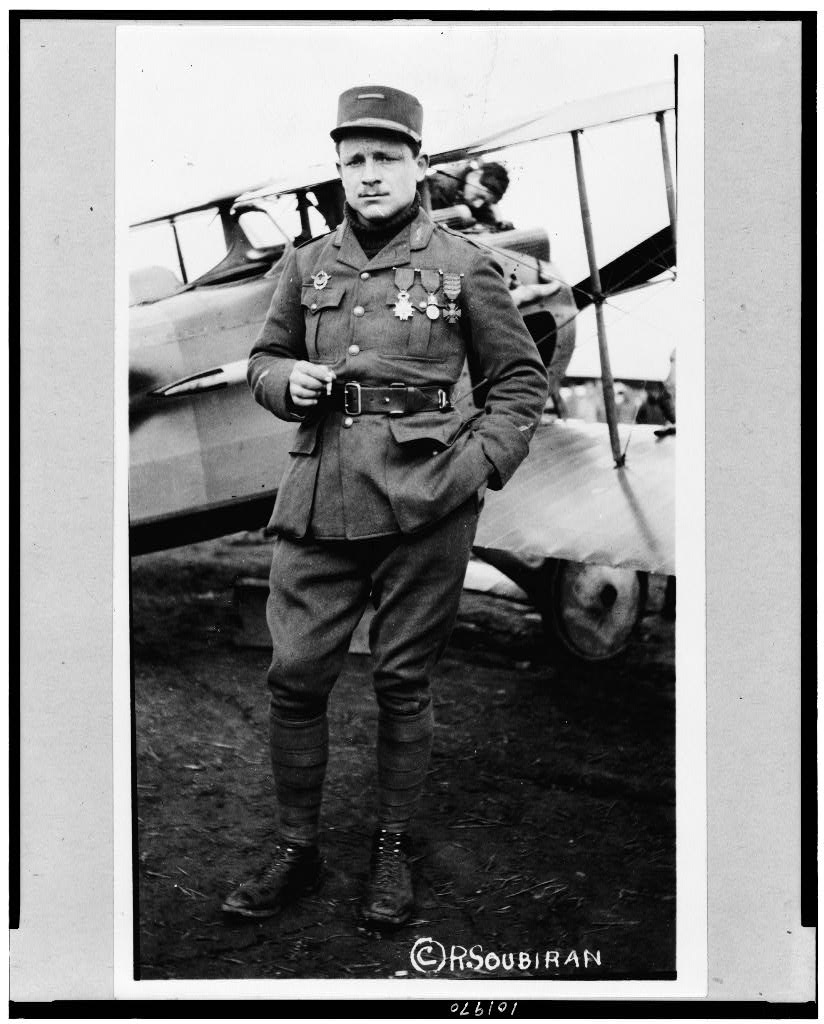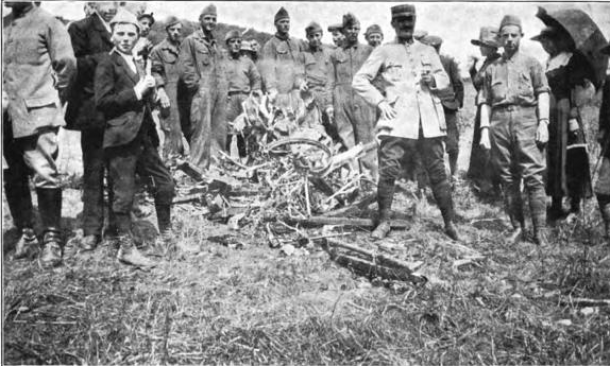By David Drury
Major Gervais Raoul Lufbery spent only two years of his brief, nomadic life in Connecticut and today his name is largely forgotten, but during his lifetime, Lufbery was probably the state’s greatest hero of the First World War.
He became America’s first air ace and his exploits with the Lafayette Escadrille and the newly formed United States Army Air Service made him a household name across the country. His fiery death on May 19, 1918, in the skies over France was a major story and a loss that his adopted hometown of Wallingford felt keenly. There, a local park, a street and the Veterans of Foreign Wars Post all are named in Lufbery’s honor.
Globetrotting Lufbery Lands in Wallingford
Lufbery, who died at age 33, led an eventful life. The various accounts of his childhood and young adulthood differ in some particulars but agree that he was born in France on March 14, 1885. His mother, a French woman, died during Raoul’s infancy. His father, Edward Lufbery, an American, left Raoul and two older brothers in the care of their maternal relatives and in 1890 remarried and emigrated to the United States. The Lufbery family lived in New York and New Jersey before settling in Wallingford, where Edward, again a widower following the death of his second wife, worked as stamp dealer while struggling to support five small children.
The teen-aged Raoul spent several years working in France, forwarding much of his pay to help support his father’s second family. Then, at age 19, he decided to see the world. He traveled through North Africa, Constantinople (Istanbul), the Balkans, and Germany, working odd jobs and never staying in one place too long. In 1906, Lufbery crossed the Atlantic to visit his father, only to learn upon reaching the United States that Edward had returned to Europe. Unfazed, Raoul spent the next two years in Wallingford where he lived with his older brother Charles and his sister-in-law and worked at a silver-plating factory. It was the only time Raoul Lufbery ever spent in Connecticut.
French Aviator and WWI Inspired a New Career
After leaving Wallingford in 1908, Lufbery traveled to Cuba and New Orleans before eventually reaching San Francisco, where he enlisted in the US Army. He spent his service in the Philippines, where he become an expert marksman, and then traveled to Japan and China after his enlistment expired. In 1912 while visiting India he met pioneer French aviator, Marc Pourpe. Their resulting friendship determined the course of Lufbery’s life. He became Pourpe’s chief mechanic and the duo spent the next two years demonstrating the mystery of manned flight to crowds in India, China, and Egypt, before returning to France in the summer of 1914.
In August 1914, France and Germany went to war, a war that later drew in many nations, including the United States and England. Pourpe enlisted in the French air service, while Lufbery, a US citizen, joined the French Foreign Legion.
Upon learning of Pourpe’s death in December 1914, Lufbery sought and was granted permission to enlist in aviation school. He initially trained on two-seaters and flew missions with a bomber squadron before transferring to combat fighter school in April 1916, where he learned to fly the standard French combat aircraft, the Nieuport.

Lafayette Escadrille, Lt. Raoul Lufbury – Library of Congress, Prints and Photographs Division
The Lafayette Escadrille
The following month, in May 1916, Sergeant Lufbery joined a newly formed squadron of American volunteer combat pilots. The squadron, led by French officers, was initially called the Escadrille Américaine; diplomatic niceties (the United States had not yet entered the war) forced a change to the name by which history would recognize it—the Escadrille Lafayette (No.124), or Lafayette Escadrille.
The Lafayette Escadrille existed for less than two years, but in that time its pilots developed a reputation for devil-may-care derring-do that would inspire US combat pilots for generations to come. The squadron consisted of 38 American pilots and four French officers. It formed the basis of the Lafayette Flying Corps–the name given to approximately 270 American aviators who were attached to French squadrons during the war. Many of those pilots became flight instructors and trainers for the fledgling US Army Air Service during the last year of the Great War (the name by which the conflict was known prior to the Second World War and the term many in Europe still use).
Like Lufbery, many of the Lafayette Escadrille pilots had previously joined the Foreign Legion or had otherwise volunteered to serve France after war broke out. Most were in their early 20s, college educated and the scions of wealthy East Coast families. They came from very different backgrounds than the self-made Lufbery, who spoke French much better than English. Still, his maturity, his coolness under fire, and his dedication to his craft quickly won over his squadron mates and in October 1916 “Luf” became the first recognized American air ace after downing his fifth enemy aircraft.
Flying Ace Commissioned into US Service
Lufbery’s fame continued to rise as the number of his “kills” grew following America’s entry into the war in April 1917. Ultimately, Lufbery was credited with 17 confirmed enemy aircraft shot down, though aviation scholars generally believe that the actual number was considerably higher. Published photos showing Lufbery relaxing at the base, rough-housing with the squadron’s mascots, two healthy lion cubs named Whiskey and Soda, added further luster to his celebrity.
In November 1917, Lufbery was commissioned into the US Army Air Service. Promoted to major in January 1918, he spent the next few months training green US pilots for combat. One of those pilots, Captain Eddie Rickenbacker, went on to become the country’s leading air ace by the end of the war with 26 confirmed kills. Rickenbacker, who visited Hartford on a speaking tour in March 1919, five months after the Armistice, consistently lauded his former mentor. “Everything I learned, I learned from Lufbery,” Rickenbacker later wrote.
Lufbery was not cut out to limit his service to teaching marksmanship and leading training flights. He returned to the front with the 94th Aero Pursuit Squadron and on May 19, 1918, flew up to confront a German observation plane near Toul, France. The dogfight that followed ebbed and flowed until, according to witnesses, Lufbery’s plane suddenly and unexpectedly caught fire.
Honored in France and US
From a height of hundreds of feet, with no parachute, he jumped from the burning fuselage, landed on a garden fence and was killed instantly. The following day, a bevy of high-ranking French and American officers attended his funeral. His burial merited full military honors and received extensive coverage in the press of the Allied nations. Less than two weeks later, Lufbery’s passing was featured in somber Memorial Day observances in Connecticut, including those in Wallingford, which were attended by his father, two sisters, and other relatives.
In the 1920s, Lufbery’s remains were moved to the Lafayette Escadrille Memorial established near Versailles, France, as a permanent monument to the 68 American pilots and their French officers who lost their lives during the Great War. Nine members of the Lafayette Escadrille are buried there, including another Connecticut pilot, Sergeant Paul Pavelka of Madison, who died while on duty in the Balkans in November 1917. The name of a third Connecticut pilot, Corporal Schuyler Lee of New London, a member of the Lafayette Flying Corps who died in combat over France in April 1918, is also inscribed in the memorial.
The New England Air Museum in Windsor Locks maintains a permanent exhibit on the Lafayette Escadrille and Flying Corps, and Lufbery’s story prominently features there. On May 1, 2004, the United States Air Force Vice Chief of Staff visited the New England Air Museum to present a long overdue Purple Heart—one of the nation’s most esteemed military honors—to Lufbery’s descendants.
David Drury, a retired editor of The Hartford Courant and lifelong student of history, regularly contributes articles about Connecticut history to The Courant and other publications.









